Let's take a journey through the next few pages together. Get to the end, and I promise you'll have a better fitting bra size.
HerRoom CEO/Founder
It’s one thing to describe how a bra should fit, but in the end you are the ultimate arbiter on what bra size and style you ultimately decide to wear. Here is a list of great bra fit tests along with tips and recommendations to help you hone in on a bra size that is your personal best.
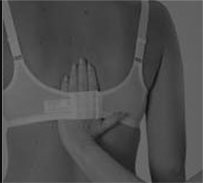
STARTING POSITION
Ask someone to slide their hand between your back and the back of your bra.
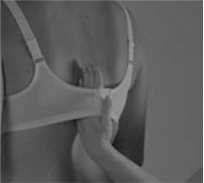
JUST RIGHT
Then have them turn their hand 90 degrees so that it is perpendicular to your back. The hand should be firmly wedged.
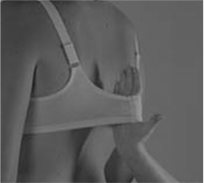
TOO LOOSE
They should not be able to pull your bra further away from your back.
The back and front of your bra band should be level and parallel to the floor when you look at yourself from the side in a mirror. If the band is too tight, digs into your flesh, is uncomfortable or the back is slightly lower (exception would be a strapless bra), it's too small. Signs that your band size is too big include breasts falling out from the bottom of your bra and your bra back riding up. A correctly sized band will fit firmly around you and not ride up in the back.
A new bra should be able to pass this test with the clasp on the loosest fitting. This allows you to tighten the bra as it stretches with wear and washing. Try to avoid buying a bra where the best fit is the bra's tightest setting. My suggestion is to always try and buy a new bra that fits on its loosest fastening position.
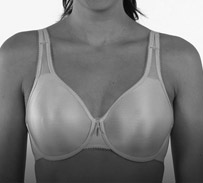
Your bra cups should be large enough to prevent breast tissue from bulging or spilling out over the neckline or armhole edges.
You'll know if your bra cups are too large if they have wrinkling, or are clearly larger than both of your breasts.
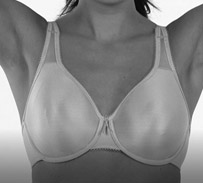
After fastening yourself into your bra, raise your arms. Does any breast tissue fall out from under the bottom of your cup? Does your bra slide up your body?
If so, your bra band may be too big. You need to tweak your bra sizing because you are still not in the right bra size.
Your bra should stay put and have no movement when you are lifting your arms.
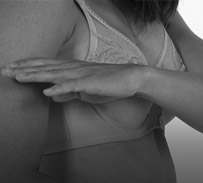
When your breasts are in their cups and hoisted to where they should be, your bra cup apex should be halfway between the top of your shoulder and your elbow. If lower than this, your band is probably too large and not giving your breasts enough support.
And, if you are D cup or larger, the bra style could be wrong and you may need a bra with seams in the cups for more breast support.
To know if you have the right size bra, you need to be sure you are "in" your bra. This is especially important for D cup sizes and larger.
Here’s what you need to do:
• Smooth any fluffy breast tissue along your bra's neckline by taking your pointer fingers, placing them inside the center of your bra, and drawing them toward the straps.
This usually gets rid of this bit of overflow. If you still have breast spillage, you need to go up one or maybe even two more cup sizes. If your bra is a balconette or demi style, this might not be the right style if you don’t like your look.
Your breasts have a natural "crease line" where the underwire should fit comfortably against your ribcage unless you have an unnatural breast crease. (Please see Additional Considerations for a detailed discussion). The diameter of your underwire is too small if the underarm end is poking breast tissue, sitting on top of breast tissue or catching your arm as it moves forward. The diameter of your underwire is too large if the underarm end is poking into your armpit.
The best underwire for you will be one that encircles your breast and gives you a more rounded and defined look. Women short in stature find that some underwires poke them under their arms because the wires are simply too tall for their body frame. One solution is to select demi and plunge bras - both styles have shorter underwires, and thus will not poke. Also, HerRoom identifies all bras with shorter underwires by grouping them in the petite plus size area of our bra department.
1. Put on your bra properly, then assess your underwires.
2. Assess your underwires in the middle of your chest.
Underwires are tilting forward and away from your chest - This is usually a sign that you need a larger cup size. But, this could also be caused by having touching breasts or splayed breasts.
For a more detailed discussion about this, please refer to our Breast Separation section.
3. The underwires in the middle of your chest should be resting comfortably against your sternum. The one exception to this would be a minimizer style bra.
Underwires are coming up too high in the center - If so, chances are you are short waisted or petite in height. You would be better served with a demi, balconette, or a plunge bra style, which tends to have shorter underwires.
HerRoom works very closely with all our vendors to identify bras that work on petite women with a plus-size figure. Please see our petite plus size bras section in HerRoom’s bra department.
CENTER PANEL TEST
It's best if the center panel between the cups of your bra sits firmly against your chest (sternum). However, there are some exceptions.
Poke your center panel or bridge toward your chest. Does your panel rest on your sternum or does your entire bra move when you poke your bra in the center? If it’s moving (and you do not have touching or splayed breasts), chances are you could go up a cup size - even 2 cup sizes - and get a better fit.
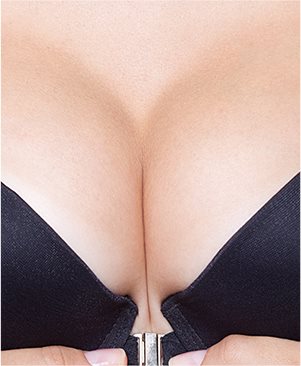
BRA STRAP TEST
Shoulder straps on a bra should rest flat on your shoulders. They shouldn't cause dents or fall off your shoulders. Shoulder straps are designed to carry minimal breast weight (10% or less). If your shoulders have dents from your straps, then your straps are working too hard - you probably need a smaller band size to give your bra more support.
With your bra on, drop your bra straps off your shoulders. Your bra should stay pretty much in place, but maybe move down just a little. If, however, your bra falls off, or significantly drops, your bra straps are doing too much of the lifting. Go down a band size (and up a cup size if the cups fit) and see what an improvement in support a smaller band size makes. And, if you are larger than a D cup, a bra with an underband worked into the design that goes under the cups will give you even greater support.
WHY ARE MY BRA STRAPS SLIPPING?When trying on a new bra, it should feel snug on the first row of eyes. If the bra feels too loose, consider going down a band size (and up a cup size if you feel the cup size is correct).
Put on your new bra, then sit. Is it still comfortable? Sitting tends to give you a wider band size, and if you have a bit of a tummy, you will find your tummy moving up your torso once you sit down. If your bra is uncomfortable sitting, look for a bra style with an arched center panel - this gives the top of your tummy more room - or a bra style without an under band.
Next, while sitting, lean forward. Does your bra gap in the cups? If yes, this bra style probably has too much cup coverage for you. A better choice could be a bra with less cup coverage.
This test is particularly great for women with larger cup sizes. Hop up and down a few times while wearing your new bra. Do your girls stay in their cups? If yes, you’ve got a winner. If your breasts start bouncing like crazy and seem to be coming out of your cups, your bra is probably one band size too large.
If you get a lot of flesh wiggle along the top of your bra cups, your cup size could be too small. But, keep in mind that unless your bra is a sports bra, there will be some movement – it just shouldn’t be so much that you feel pain on your breast’s down swing.
If you are trying this test while wearing a demi, balconette or plunge bra, all bets are off – these styles don’t promise to keep you contained if hopping.
If you’re looking for a high impact sports bra, this jump test is a must. In fact, 10 jumping jacks in a sports bra is a quick test of its support.
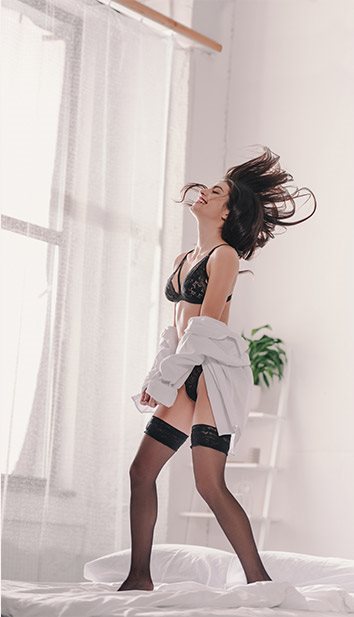
Find your best bra size
Fast
No measuring tape needed
Let's take a journey through the next few pages together. Get to the end, and I promise you'll have a better fitting bra size.
HerRoom CEO/Founder
Find your best
Bra Styles
By Tomima
You know your bra size. But, do you know your breasts? Sounds like a funny question, but certain bras styles and features work better for some breasts and not for others.
Answer the following questions, and I promise your new bras will make you look younger and thinner!
We are sorry we are unable to assist you further.
